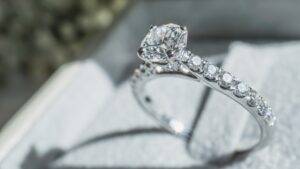
When it comes to choosing the perfect engagement ring, couples today have more options than ever before. One increasingly popular choice is lab-grown diamonds.
These lab grown diamond engagement rings offer numerous benefits, from ethical considerations to affordability and quality. However, navigating the world of lab-grown diamonds can be daunting for those unfamiliar with the industry. In this buying guide, we will explore everything you need to know about purchasing lab-grown diamonds for an engagement ring.
Lab-grown diamonds, also known as synthetic or cultured diamonds, are created in a controlled environment that replicates the natural diamond-growing process. Through advanced technological processes, scientists recreate the conditions found deep within the Earth’s mantle, where diamonds form over millions of years. The result is a diamond with identical chemical, physical, and optical properties to mined diamonds.
Benefits of Lab-Grown Diamonds
If you are considering lab grown diamonds for your engagement ring, you have made a good choice. Here are important benefits that come with this precious gemstone:
Ethical Sourcing
One of the most significant advantages of lab-grown diamonds is their ethical sourcing. Unlike mined diamonds, which may be associated with environmental damage and unethical labor practices, lab-grown diamonds are conflict-free and have a minimal environmental impact.
Value and Affordability
Lab-grown diamonds typically cost 20-40% less than mined diamonds of similar quality and size. This affordability allows couples to purchase a larger or higher-quality diamond within their budget, without compromising on ethics or quality.
Quality Control
Because lab-grown diamonds are created under controlled conditions, they often exhibit fewer inclusions and flaws than mined diamonds. Additionally, buyers can be confident in the consistency and quality of lab-grown diamonds, as they are produced to exact specifications.
Environmental Sustainability
The process of mining diamonds can have a significant environmental impact, including habitat destruction and carbon emissions. In contrast, lab-grown diamonds require minimal environmental disruption and have a smaller carbon footprint, making them a more sustainable choice for eco-conscious consumers.
Factors to Consider When Purchasing Lab-Grown Diamonds
When buying lab-grown diamonds for your engagement rings, there are vital factors to consider to get value for your money. These include:
Certification
Just like mined diamonds, lab-grown diamonds should be certified by reputable gemological laboratories such as the Gemological Institute of America (GIA) or the International Gemological Institute (IGI). These certifications ensure that the diamond meets industry standards for quality and authenticity.
Quality Grading
Lab-grown diamonds are graded using the same criteria as mined diamonds, including the four Cs: cut, color, clarity, and carat weight. It’s essential to consider these factors when selecting a lab-grown diamond for an engagement ring, as they will determine the diamond’s overall appearance and value.
The Gemstone Cut
The cut of a diamond refers to its proportions, symmetry, and polish, which ultimately impact its brilliance and sparkle. When choosing a lab-grown diamond, opt for a well-cut stone to maximize its beauty and light performance.
Shade and Color
Lab-grown diamonds are available in a range of colors, from colorless to fancy colored diamonds. The most popular choice for engagement rings is typically a colorless or near-colorless diamond, as these stones exhibit a classic and timeless beauty.
Gemstone Clarity
Clarity refers to the presence of inclusions or blemishes within the diamond. While most lab-grown diamonds are relatively free from inclusions, it is essential to select a stone with minimal imperfections to ensure maximum brilliance and clarity.
Carat Weight
Carat weight refers to the size of the diamond and is often a significant factor in its cost. When choosing a lab-grown diamond for an engagement ring, consider your budget and personal preferences regarding diamond size.
Ring Setting
The setting of the engagement ring can significantly impact the appearance of the lab-grown diamond. Whether you opt for a classic solitaire setting or a more intricate halo or pave setting, ensure that the setting enhances the beauty of the diamond and complements your personal style.
Final Thoughts
Choosing the perfect engagement ring is an exciting and meaningful decision, and opting for a lab-grown diamond offers numerous benefits. Therefore, lab-grown diamonds provide a compelling alternative to mined diamonds. By understanding the factors to consider when purchasing a lab-grown diamond and selecting a stone that meets your criteria and preferences, you can ensure that your engagement ring symbolizes your love and commitment in the most beautiful and ethical way possible.
Read more:
Buying Guide: Lab Grown Diamonds for Engagement Ring

